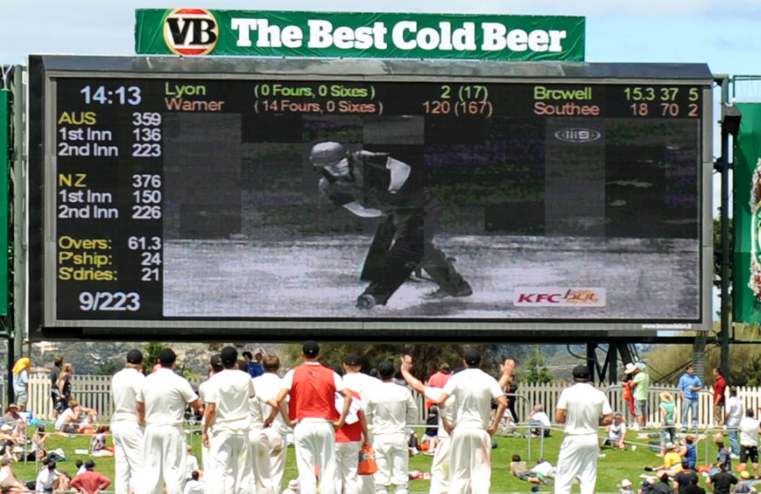Test Match Therapy: Those That Stopped a Nation 5
0By Euan McCabe
Australia at Hobart, December 9-12, 2011
NZ 150 & 226
Australia 136 & 233
New Zealand won by 7 Runs
New Zealand had been thumped in the First Test in Brisbane a week earlier and then spent most of this one stalked by that familiar Trans-Tasman fog of lost opportunity and glum inevitability. Indeed, it is only by the wafer-thin margin of seven runs and one memorable Doug Bracewell delivery that this Test finds itself in this celebrated category as opposed to the one titled ‘The Most Irritating, Exasperating and Insufferable’. Even the much-celebrated fourth day fightback was in jeopardy of ending in years of anguish – I mean, can anybody possibly imagine just how sickening David Warner’s victory celebration would have been?
The Hobart pitch was so green and overhead conditions so threatening that captain Michael Clarke broke with centuries of Australian tradition by declining to bat after winning the toss. It looked a sound decision when the Black Caps were skittled for 150, but not quite so flash when Australia slumped to 75 for 7 in reply.
Then came that perennial lower order batting resistance from the Australian tail which happens regardless of whether the home side is 450-5 or 75-7. They cut the deficit to just 14 and the Black Caps chance of a first innings lead of substance on a difficult pitch was gone. Still, New Zealand finished the second day in the sound position of 153 in front with seven second innings wickets remaining.
Captain Ross Taylor and a fresh-faced Kane Williamson had looked as comfortable as anybody on this pitch during the closing stages of Day 2. This was the embryonic stages of what would evolve with time into the The Old Firm; New Zealand’s most successful ever batting combination (running between the wickets aside). I don’t know about you, but when New Zealand is batting in a tense Trans-Tasman situation I treat every single ball as if it will be the one that will explode in our faces and lead to a match-ending collapse. It just comes with experience. It was therefore a huge relief when these two managed to navigate a personally agonising but relatively safe passage to stumps without setting off a mine.
But I am also betwixt in these situations by the thought that if things are proceeding so well then perhaps it would actually be better if an established partnership such as this one was able to carry on without its concentration or momentum being broken.
Kane Williamson was out third ball the following morning, and New Zealand added just 87 further runs before being bowled out. If only Taylor and Williamson had batted on through the night. But all done and dusted, 241 to win still looked challenging on this wicket. We just had to get an early breakthrough and build some pressure on a pitch that would hopefully continue to produce sideways movement.
Then there is David Warner. Whether you love him or loathe him (most outside of Australia), Warner is the one player able to make the always challenging task of opening in Test cricket appear almost effortless. Australia was 72 for 0 at stumps, Warner 47 not out.
I am not sure when I officially gave up the next day, but at 159 for 2 a miracle was required. And remarkably, it happened. In the space of just seven deliveries Doug Bracewell dismissed Ricky Ponting, Michael Clarke and Mike Hussey; a triumvirate who scored 28,256 Tests runs between them at a combined average of 152.57. It was the kind of stuff which usually only happens in the backyard when you are a kid.
I missed the Bracewell miracle, of course, because I had officially given up. But I was alerted to it by a breathless work colleague charging towards me, shouting: “Have you seen what’s happening, have you seen what’s happening!”
I was watching now. But still with a sense of impending doom as Australia got to lunch at 173 for 5; and shortly after the break we all got to enjoy the leap-in-the-air-kiss-the-badge-on-the-helmet celebration as David Warner reached three figures. I was not watching now.
It was a roar from somewhere down the corridor which prompted me to scurry back to the nearest television set. Australia had lost two wickets. What a bonus: I was expecting one but got two instead. Tim Southee had effected a double break-through. And that was soon copied by Doug Bracewell. Incredibly, Australia slumped from 192 for 5 to 199 for 9. I was already feeling rather giddy at this stage but almost fainted when I suddenly realised that we were now potentially just one ball away from winning our first Test against Australia in almost two decades.
The next hour or so somehow managed to be both the worst and the best of my cricketing life. I knew there would be resistance, especially as David Warner’s increasingly irritating presence was still out in the middle. But 42 runs worth of resistance? On this pitch? With Tim and Doug swinging it both ways? Surely not. The key to victory became Nathan Lyon, the last Australian batsman and a man relatively new at the time to Test match cricket.
I have always liked Nathan Lyon. There is a certain uncomplicated plainness about him which gives hope to all club cricketers. In fact, when I first saw the former groundsman bowl at Test level I was surprised to see somebody who bowled like, well, a groundsman. It is therefore remarkable to think how he has subsequently developed into one of the smartest and best off-spin bowlers anywhere in world cricket. And his batting is useful too. He stands tall and gets into line, watches the ball carefully, and has a reasonably sound technique for somebody who usually bats at 11. I can think of a few line-ups in Test cricket where he would be higher up the order.
But these qualities are not what you want when requiring one last wicket to break a 19-year drought. Rather, you hope somebody like Chris Martin appears from the tunnel (either the former Black Cap seamer or the Coldplay frontman – I’m not fussy). But straight away I was concerned about Lyon – he looked just the man to hold his end up in support of Warner. And he looked pretty unflappable too. Just doing his job; much like a groundsman.
Warner and Lyon had added 17 and cut the deficit to 25 when Tim Southee got one to swing back in and strike Lyon on the pads. The whole New Zealand team went up. It looked out. Umpire Nigel Llong thought so too, raising his finger, and sparking celebrations around our television. My heart pounded with excitement and I clinched a fist. But I remained seated and displayed little outward emotion. Because I knew it would be reviewed. And it was.
Under normal circumstances these LBW reviews always seem to take so long. This one seemed to take forever. Check the bowler’s front foot; check for any contact with the bat; roll it back and forward a few times… For God’s sake, just get on with it. We all knew what we were waiting for here – the ball tracker. But when it finally came my heart sank and my mouth dropped open in disbelief – it showed the ball both pitching outside and then missing leg stump. How could something that looked so out – even to an umpire standing in line 22 yards away – not just be not out, but be not out twice.
I was still grappling with this concept, and admiring my restraint, when Southee bowled a ball that swung too much, brushed the outside of Nathan Lyon’s pad on the way past and raced down to the fine leg boundary for four leg byes. I let out a moan of despair that sounded like a dying cow. At least the LBW review had been a dot ball: Four precious runs conceded at this stage and in this manner actually felt far worse.
With 18 left to win, Bracewell beat Lyon and rapped him on the pads. The appeal was not quite so unified or convincing this time, but few were surprised when Ross Taylor went upstairs. What else was he supposed to do? This review was hopeful as opposed to expectant; leaving you to shut your eyes and just pray that the last one looked out but was given not out, so maybe this one looked not out but will be out. The ball tracker showed it missing the stumps. Now you just have one tiny shred of hope left – that the Third Umpire gets a bit distracted or confused and perhaps pushes the wrong button. He did not.
It was at this point I realised it was not going to happen. There was just too much going against us. I started to mull over the Test matches in Australia where we had been robbed:
Sydney 1974 (rain), Melbourne 1987 (cheating and umpiring), Perth 2002 (umpiring), now Hobart 2011 (ball tracker). And you can posthumously add Adelaide 2015 to that list (third umpiring – and remarkably, again involving both Nigel Llong and Nathan Lyon). I came to the rather depressing conclusion that we had more in the Robbed column than we actually had in the Win column.
But I had to keep watching. Just in case. When it gets down to eight runs required, however, you realise it is too late; one half-volley and then an uncontrolled edge and the match is over.
It is hard to describe. When Bracewell got one to swing in and keep low, beating the late bat of Lyon and knocking over his stumps, initially I thought I was dreaming: that I had willed this to happen so much that my image had shifted from my brain onto the television screen.
But reality quickly followed and it triggered so many emotions – disbelief, euphoria, excitement, happiness, pride. But there was one emotion which stood above all the others; and still does today, a decade later
Relief.
Follow Euan on Twitter
Test Match Therapy series

